2003 PONTIAC GRAND PRIX radiator cap
[x] Cancel search: radiator capPage 265 of 378
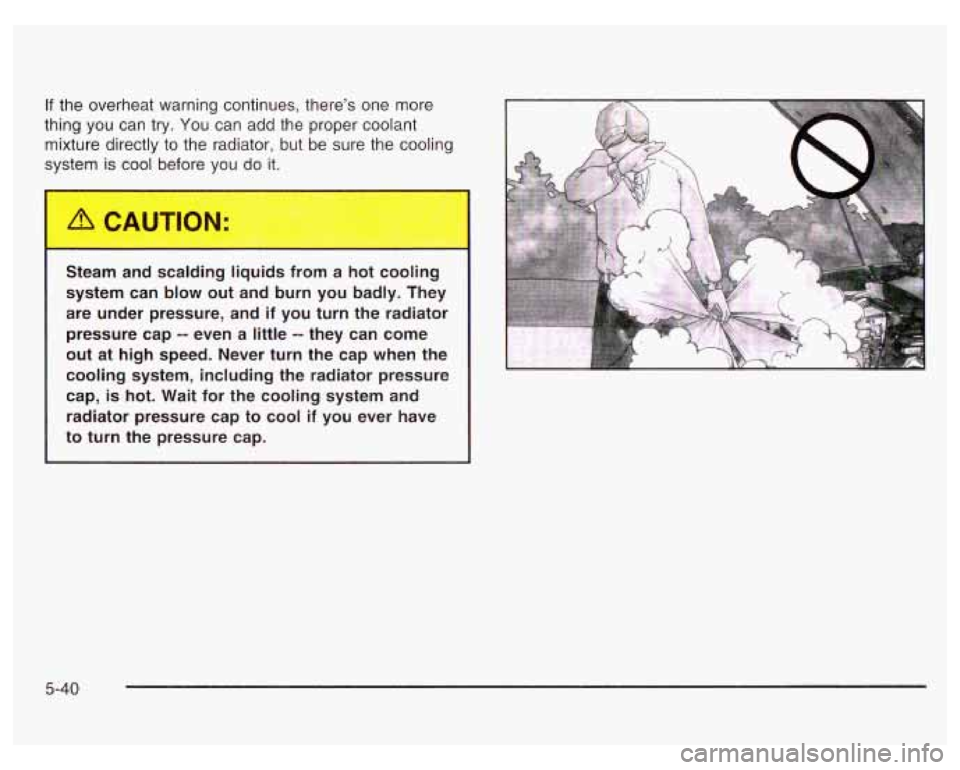
If the overheat warning continues, there’s one more
thing you can try. You can add the proper coolant
mixture directly to the radiator, but be sure the cooling
system is cool before you do it.
Steam and scalding liquids from a hot cooling
~
system can blow out and burn you badly. They
are under pressure, and if you turn the radiator pressure cap
-- even a little -- they can come
out at high speed. Never turn the cap when the
cooling system, including the radiator pressure
cap,
is hot. Wait for the cooling system and
radiator pressure cap to cool if you ever have
to turn the pressure cap.
5-40
Page 266 of 378
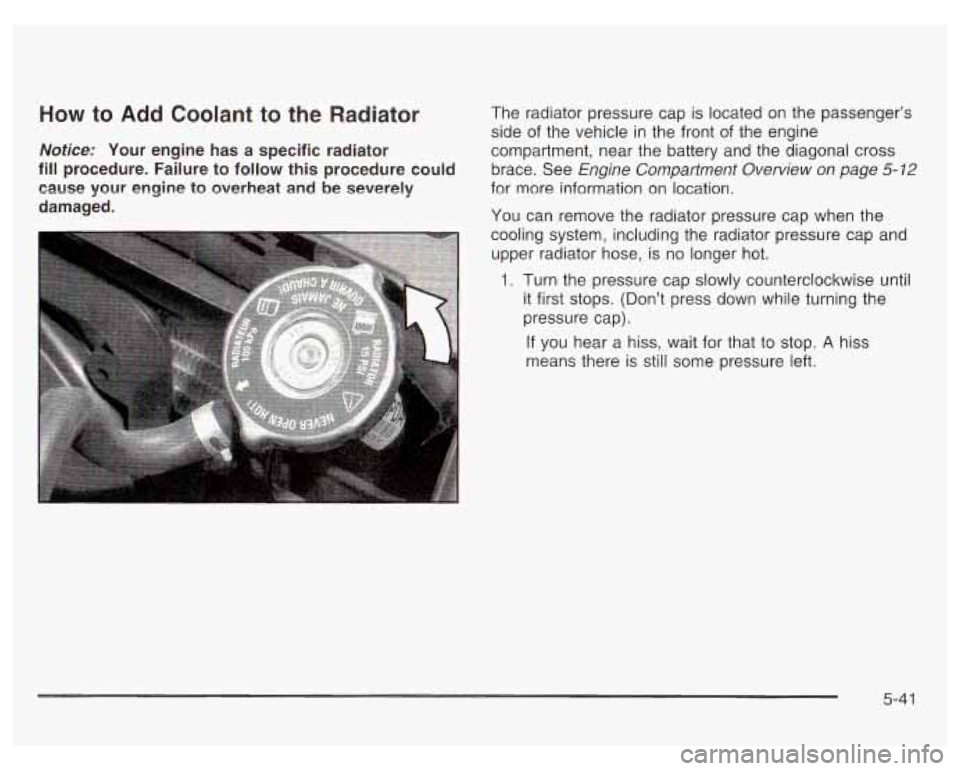
40w to Add Coolant to the Radiator The radiator pressure cap is located on the passenger’s
side of the vehicle
in the front of the engine
dotice: Your engine has a specific radiator compartment, near the battery and the diagonal cross
ill procedure. Failure to follow this procedure could brace. See Engine Compartment Overview on page 5-12
:ause your engine to overheat and be severely for more information on location.
lamaged. You can remove the radiator pressure cap when the
cooling system, including the radiator pressure cap and
upper radiator hose, is no longer hot.
1. Turn the pressure cap slowly counterclockwise until
it first stops. (Don’t press down while turning the
pressure cap).
If you hear a hiss, wait for that to stop. A hiss
means there is still some pressure left.
5-4 1
Page 269 of 378
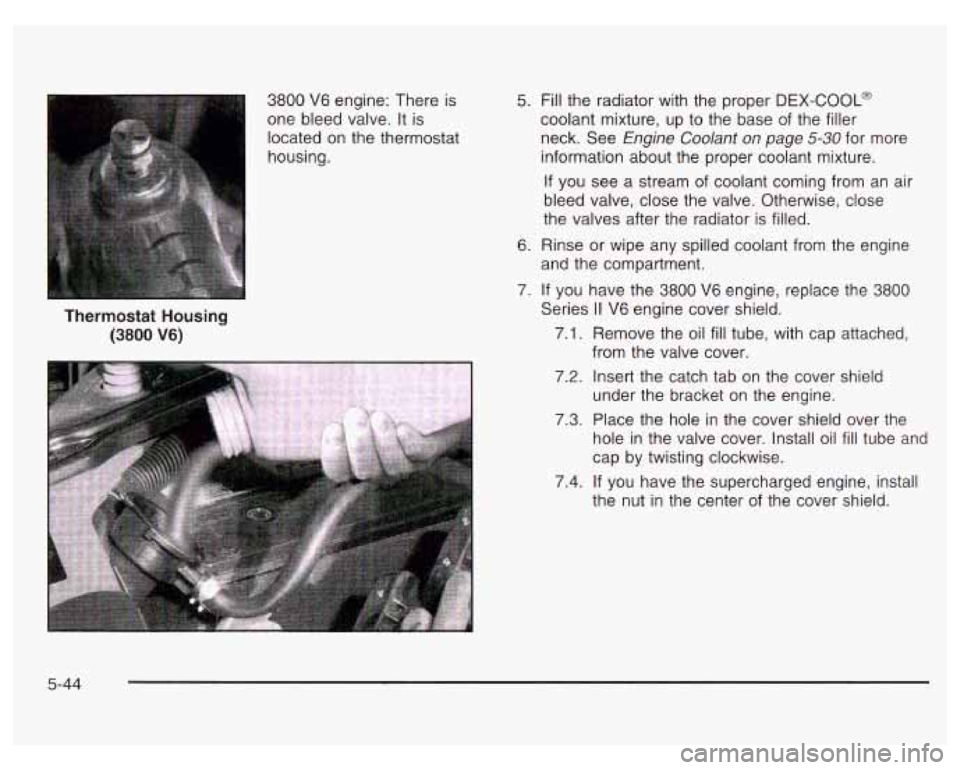
3800 V6 engine: There is
one bleed valve. It is
located on the thermostat
housing.
Thermostat Housing
(3800 V6)
5. Fill the radiator with the proper DEX-COOL@
coolant mixture, up to the base of the filler
neck. See Engine Coolant
on page 5-30 for more
information about the proper coolant mixture.
If you see a stream of coolant coming from an air
bleed valve, close the valve. Otherwise, close
the valves after the radiator is filled.
6. Rinse or wipe any spilled coolant from the engine
and the compartment.
7.
If you have the 3800 V6 engine, replace the 3800
7.1. Remove the oil fill tube, with cap attached,
Series
II V6
engine cover shield.
from the valve cover.
7.2. Insert the catch tab on the cover shield
under the bracket
on the engine.
7.3. Place the hole in the cover shield over the
hole
in the valve cover. Install oil fill tube and
cap by twisting clockwise.
7.4. If you have the supercharged engine, install
the nut in the center
of the cover shield.
5-44
Page 270 of 378
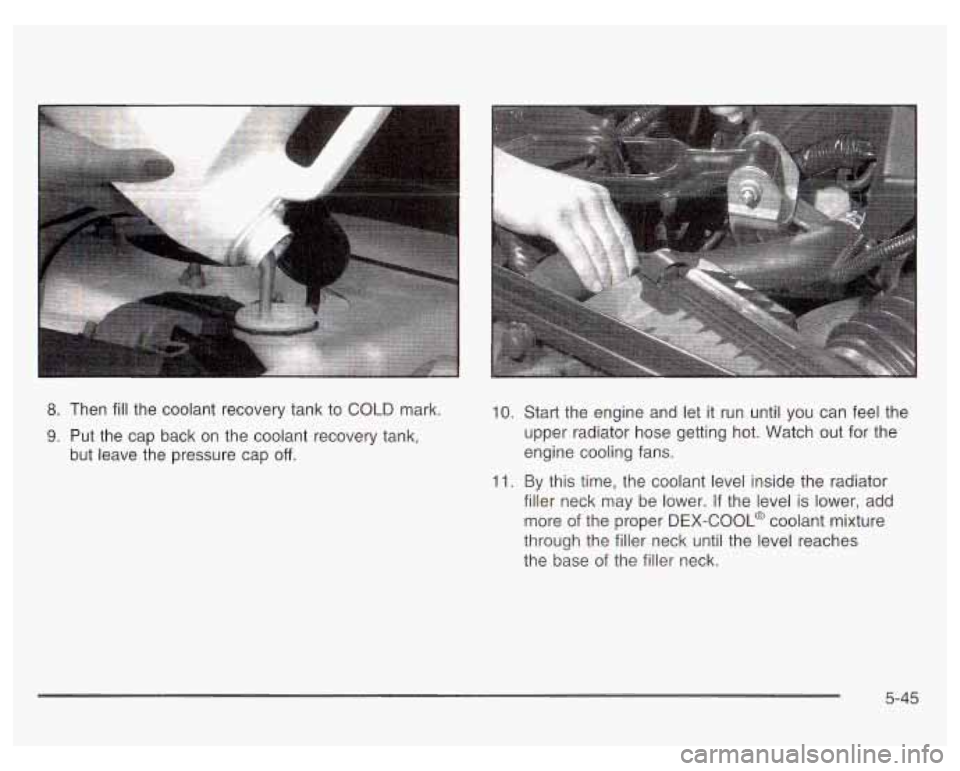
8. Then fill the coolant recovery tank to COLD mark.
9. Put the cap back on the coolant recovery tank,
but leave the pressure cap
off.
10. Start the engine and let it run until you can feel the
upper radiator hose getting hot. Watch out for the
engine cooling fans.
11. By this time, the coolant level inside the radiator
filler neck may be lower.
If the level is lower, add
more
of the proper DEX-COOL@ coolant mixture
through the filler neck until the level reaches
the base of the filler neck.
5-45
Page 337 of 378

82,500 Miles (137 500 km)
0 Rotate tires. See Tire Inspection and Rotation on
page
5-69 for proper rotation pattern and additional
information. (See footnote
+.)
90,000 Miles (150 000 km)
0 Replace engine air cleaner filter. An Emission
Control Service.
0 For supercharged engines only: Check the
supercharger oil level and add the proper
supercharger oil as needed (or every 36 months,
whichever occurs first). See Part D: Recommended
Fluids and Lubricants on page
6-15. An Emission
Control Service. (See footnote
f.)
Ll Rotate tires. See Tire Inspection and Rotation on
page 5-69 for proper rotation pattern and additional
information. (See footnote
+.)
97,500 Miles (162 500 km)
U Rotate tires. See Tire Inspection and Rotation on
page 5-69 for proper rotation pattern and additional
information. (See footnote
+.)
100,000 Miles (1 66 000 km)
0 Inspect spark plug wires. An Emission Control
0 Replace spark plugs. An Emission Control Service.
Service.
CI Change
automatic transaxle fluid and filter if the
vehicle is mainly driven under one or more
of
these conditions:
- In heavy city traffic where the outside
temperature regularly reaches
90°F (32°C)
or higher.
- In hilly or mountainous terrain.
- When doing frequent trailer towing.
- Uses such as found in taxi, police or delivery
service.
0 If you haven’t used your vehicle under severe service
conditions listed previously and, therefore, haven’t
changed your automatic transaxle fluid, change both
the fluid and filter.
150,000 Miles (240 000 km)
0 Drain, flush and refill cooling system (or every
60 months since last service, whichever occurs first).
See Engine Coolant on page
5-30 for what to use.
Inspect hoses. Clean radiator, condenser, pressure
cap and neck. Pressure test the cooling system
and pressure cap. An Emission Control Service.
0 Inspect engine accessory drive belt. An Emission
Control Service.
6-8
Page 342 of 378
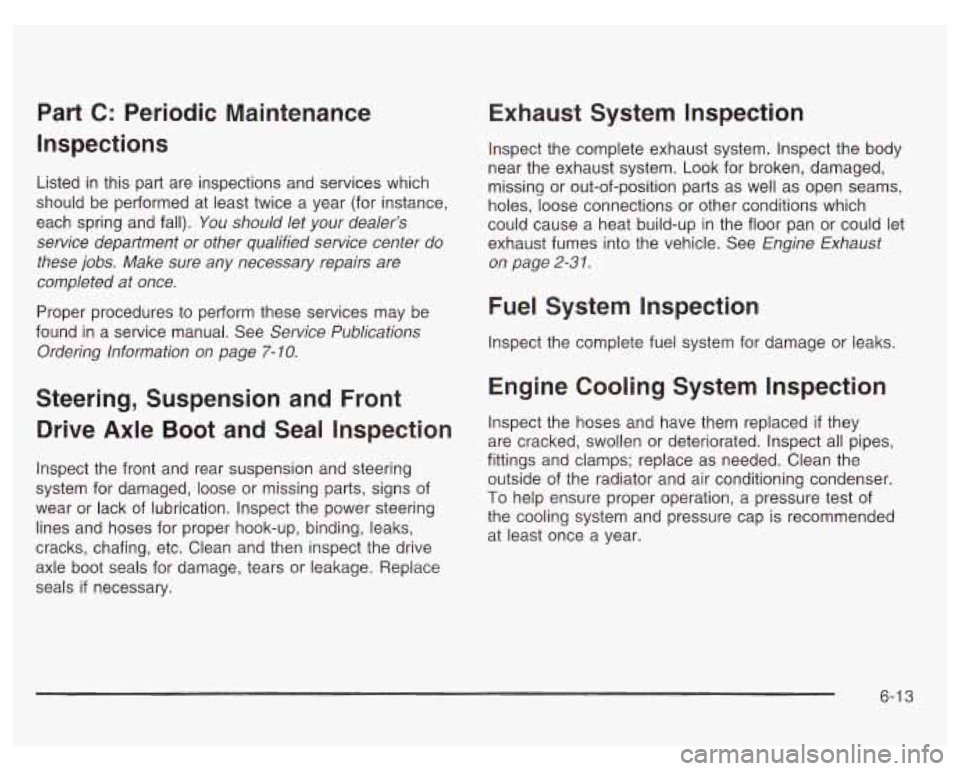
Part C: Periodic Maintenance
Inspections
Listed in this part are inspections and services which
should be performed at least twice a year (for instance,
each spring and fall).
You should let your dealer’s
service department
or other qualified service center do
these
jobs. Make sure any necessary repairs are
completed at once.
Proper procedures to perform these services may be
found in a service manual. See Service Publications
Ordering lnformation
on page 7- 10.
Steering, Suspension and Front
Drive Axle Boot and Seal Inspection
Inspect the front and rear suspension and steering
system for damaged, loose
or missing parts, signs of
wear or lack of lubrication. Inspect the power steering
lines and hoses for proper hook-up, binding, leaks,
cracks, chafing, etc. Clean and then inspect the drive
axle boot seals for damage, tears or leakage. Replace
seals
if necessary.
Exhaust System Inspection
Inspect the complete exhaust system. Inspect the body
near the exhaust system. Look for broken, damaged,
missing or out-of-position parts as well as open seams,
holes, loose connections or other conditions which
could cause a heat build-up in the floor pan or could let
exhaust fumes into the vehicle. See Engine Exhaust
on page
2-3 1.
Fuel System Inspection
Inspect the complete fuel system for damage or leaks.
Engine Cooling System Inspection
Inspect the hoses and have them replaced if they
are cracked, swollen or deteriorated. Inspect all pipes,
fittings and clamps; replace as needed. Clean the
outside of the radiator and air conditioning condenser.
To help ensure proper operation, a pressure test of
the cooling system and pressure cap is recommended
at least once a year.
6-1 3
Page 369 of 378
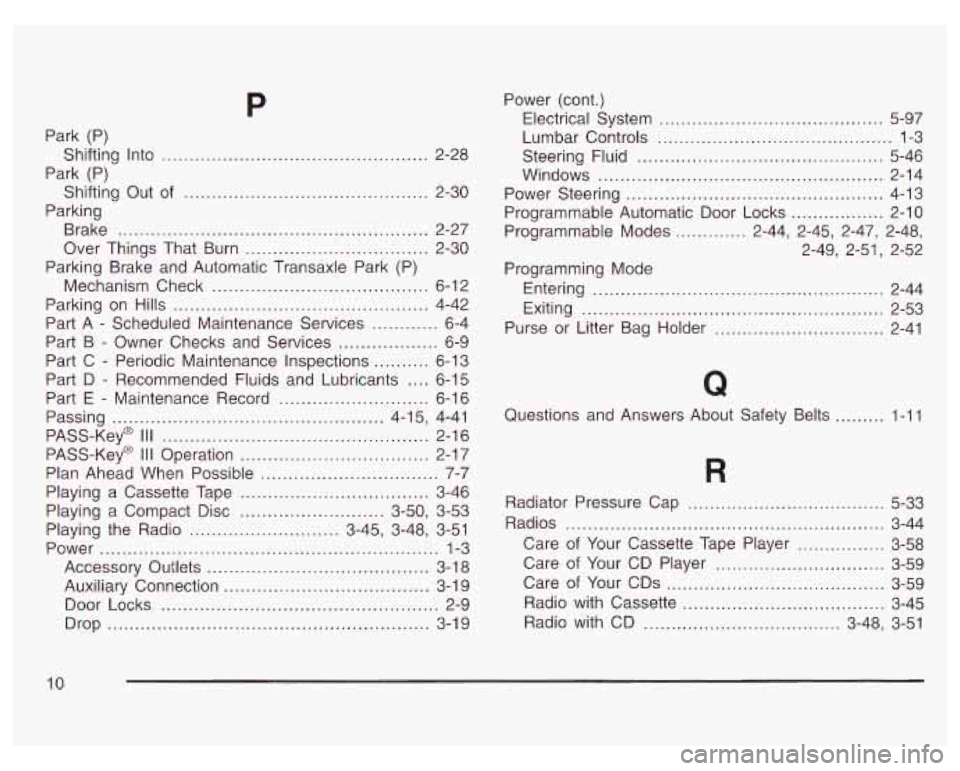
P
Park (P)
Park (P)
Parking Shifting Into
................................................ 2-28
Shifting Out of
............................................ 2-30
Brake
........................................................ 2-27
Over Things That Burn
................................. 2-30
Parking Brake and Automatic Transaxle Park (P)
Mechanism Check
....................................... 6-1 2
Parking
on Hills .............................................. 4-42
Part A
- Scheduled Maintenance Services ............ 6-4
Part
B - Owner Checks and Services .................. 6-9
Part
C - Periodic Maintenance Inspections .......... 6-13
Part D
- Recommended Fluids and Lubricants .... 6-1 5
Part E - Maintenance Record ........................... 6-16
Passing
................................................. 4-15, 4-41
PASS-Key@ Ill
................................................ 2-16
Plan Ahead When Possible
................................ 7-7
Playing a Cassette Tape
.................................. 3-46
Playing the Radio
........................... 3-45, 3-48, 3-51
Power
............................................................. 1-3
Accessory Outlets
........................................ 3-1 8
Auxiliary Connection
................................. 3-1 9
Door Locks
.............. ................. 2-9
Drop
....................... .... .... 3-19
PASS-Key@
Ill Operation .................................. 2-17
Playing a Compact Disc
.......................... 3-50, 3-53 Power (cont.)
Electrical System
......................................... 5-97
Lumbar Controls
........................................... 1-3
Steering Fluid
............................................. 5-46
Windows
.................................................... 2-14
Power Steering
............................................... 4-13
Programmable Automatic Door Locks
................. 2-10
Programmable Modes
............. 2-44, 2-45, 2-47, 2-48,
Programming Mode 2-49,
2-51, 2-52
Entering
..................................................... 2-44
Exiting
....................................................... 2-53
Purse or Litter Bag Holder
............................... 2-41
Questions and Answers About Safety Belts
......... 1-11
Radiator Pressure Cap
................................ 5-33
Radios
......................................... ......... 3-44
Care of Your Cassette Tape Player
................ 3-58
Care
of Your CD Player ............................... 3-59
Care of Your
CDs ........................................ 3-59
Radio with Cassette
..................................... 3-45
Radio with CD
.................................... 3-48, 3-51
10